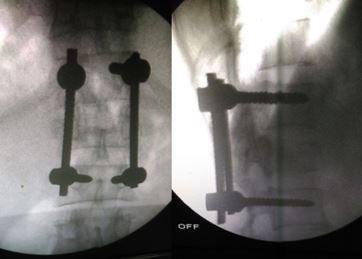Evaluation of Neurological Recovery in cases of Thoracolumbar Fracture with Paraparesis after Fixation and Decompression
Abstract
Background: The recent advances in management of Spinal Cord Injury (SCI) are born on evolving understanding of spinal mechanics, injury mechanics improved instrumentation, better imaging modalities and better rehabilitative care. However management of thoracolumbar fractures remains controversial for many reasons. The purpose of this study was to assess the neurological recovery of patients with traumatic incomplete dorsolumbar spinal cord injury, who were treated by reduction, posterior stabilization and decompression at our centre.
Material & Methods: 36 patients with incomplete spinal cord treated with posterior pedicle screw fixation and decompression were included in the study. These patients were evaluated with American Spinal Injury Association (ASIA) Impairment Scale before and after surgery and at 1, 2 and6 months follow up after surgery.
Results: Out of total 36 patients, 22 were male and 14 were female. The mean age was 33.7 years. Neurological improvement in our series was more than one ASIA Impairment Scale (AIS) grade in 24 cases with 3 cases showing improvement of two ASIA grades.
Conclusion: Posterior Decompression and Pedicle screw fixation is an effective procedure to achieve early mobilisation and rehabilitation and the evidence indicates that it leads to improvement in neurological recovery in cases of incomplete SCI.
Downloads
References
2. Roy-Camille R, Saillant G, Mazel C. Internal fixation of the lumbar spine with pedicle screw plating. Clin Orthop Relat Res 1986;203:7-17.
3. Cotler JM, Vernace JV, Michalski JA. The use of Harrington rods in thoracolumbar fractures. Orthop Clin North Am 1986;17(1):87-103.
4. Transfeldt EE, White D, Bradford DS, Roche B. Delayed anterior decompression in patients with spinal cord and cauda equina injuries of the thoracolumbar spine. Spine 1990;15(9):953-957.
5. Anderson PA, Henley MB. Early stabilization and decompression for incomplete paraplegia due to a thoracic-level spinal cord injury. Spine 1993;18(14):2080-7.
6. Rahimi-Movaghar V. Efficacy of surgical decompression in the setting of complete thoracic spinal cord injury. J Spinal Cord Med. 2005;28:415–420.
7. Bohlman HH, Eismont FJ. Surgical techniques of anterior decompression and fusion for spinal cord injuries. Clin Orthop Relat Res. 1981;154:57-67.
8. Clark WK. Spinal cord decompression in spinal cord injury. Clin Orthop Relat Res 1981;154:9-13.
9. Wood K, Butterman G, MehbodA, Garvey T, Jhanjee R, Sechriest V. Operative compared with nonoperative treatment of a thoracolumbar burst fracture without neurological deficit: a prospective randomized study. J Bone Joint Surg. 2003;85A:773-81.
10. Lee JY, Vaccaro AR, Lim MR, et al. Thoracolumbar injury classification and severity score: a new paradigm for the treatment of thoracolumbar spine trauma. J Orthop Sci 2005;10(6):671–5.
11. Fehlings MG, Perrin RG. The timing of surgical intervention in the treatment of spinal cord injury: a systematic review of recent clinical evidence. Spine 2006;31:28–35.
12. Kirshblum SC, Stephen PB, Sorensen FB, et al. International Standards for Neurological Classification of Spinal Cord Injury (Revised Edition). J Spinal Cord Med 2011;34(6):535-46.
13. Frankel HL, Hancock DO, Hyslop G, et al. The value of postural reduction in the initial management of closed injuries of the spine with paraplegia and tetraplegia. Paraplegia 1969;7(3):179-192.
14. Jun DS, Yu CH, Ahn BG. Posterior direct decompression and fusion of the lower thoracic and lumbar fractures with neurological deficit. Asian Spine J. 2011;5(3):146-154.
15. Lee DY, Park YJ, Song SY, Hwang SC, Kim KT, Kim DH. The importance of early surgical decompression for acute traumatic spinal cord injury. Clin Orthop Surg 2018;10:448-454.
16. Spiess MR, Müller RM, Rupp R, Schuld C, Van Hedel HJ. Conversion in ASIA impairment scale during the first year after traumatic spinal cord injury. J Neurotrauma. 2009;1;26(11):2027-36.

The entire contents of the Orthopaedic Journal of Madhya Pradesh Chapter are protected under Indian and International copyrights. Orthopaedic Journal of Madhya Pradesh Chapter allow authors to retain the copyrights of their papers without restrictions, Authors grant the publisher the right of exclusive publication. The Journal then grants to all users a free, irrevocable, worldwide, perpetual right of access to, and a license to copy, use, distribute, perform and display the work publicly and to make and distribute derivative works in any digital medium for any reasonable non-commercial purpose, subject to proper attribution of authorship. The journal also grants the right to make numbers of printed copies for their personal non-commercial use under Creative Commons Attribution-Non-commercial share alike 4.0 International Public License.

 OAI - Open Archives Initiative
OAI - Open Archives Initiative












